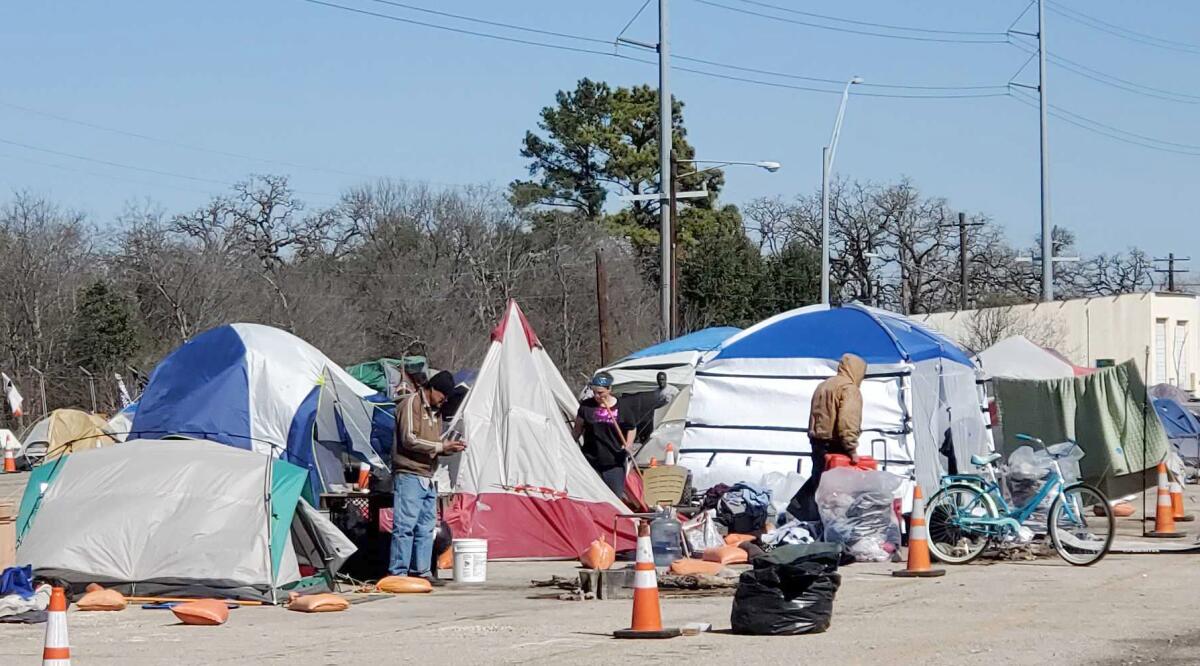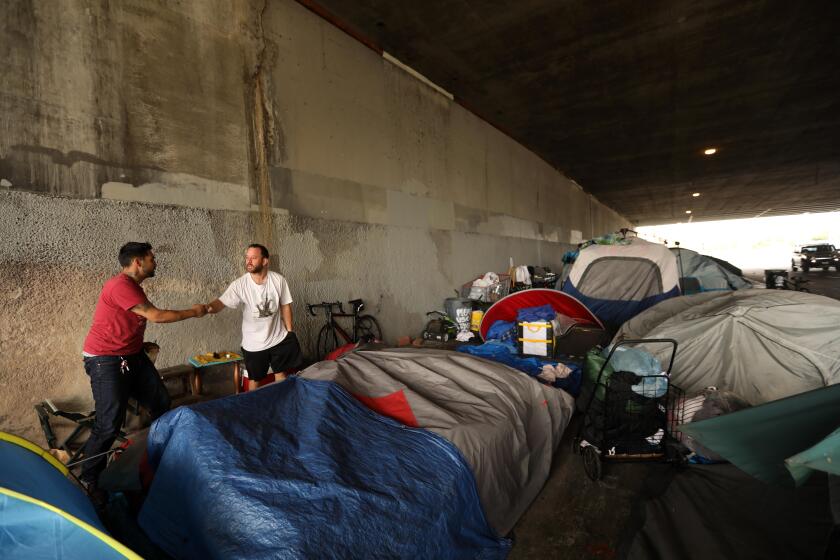As leaders spar over homelessness in Austin, California becomes a punching bag

- Share via
AUSTIN, Texas — Last June, Austin Mayor Steve Adler and fellow Democrats on the City Council passed a law effectively allowing homeless people to sleep, camp and panhandle on sidewalks and in other public spaces, as long as they didn’t threaten safety. The rationale was that the police too often played a cat-and-mouse game with the homeless population, moving them from place to place. Decriminalization was the start to a “housing-first” policy to expand access to shelter and apartments.
Residents didn’t react well. In Nextdoor posts and on local TV, images of disorderly encampments proliferated. Some reports claimed, falsely, that the city had legalized trespassing on private property and camping in public parks.
Gov. Greg Abbott, a Republican, was infuriated. He threatened to “unleash the full power of state agencies to ensure the health and safety of all Texans” if the city did not get a handle on the problem.
“San Francisco chose to tolerate homelessness & drug use,” Abbott fumed on Twitter. “It did so in the name of compassion for the homeless. It made the problems worse. The result: Street squalor & misery increased, while government expenditures ballooned. No SF in TX.”
Under pressure, the City Council reversed course in October, partly reinstating a ban on public camping. Abbott sent state employees to remove homeless people from highway underpasses and to clear encampments from state property. He set up a five-acre state-secured homeless camp at the eastern edge of the city. It has been nicknamed Abbottville, or Adlerville, depending on who is doing the criticizing.
California is not the cause of Austin’s homelessness problems, but it has become a punching bag in an escalating feud among Texas leaders.
In Texas’ capital, a booming tech and music hub, there are frequent complaints of being overrun by Californians. More than 7,000 people from the Golden State moved to this city and surrounding Travis County in 2017-18 — about a quarter of those who moved here from out of state, twice the percentage from five years earlier.
The influx of residents has no doubt raised housing prices, contributing to Austin’s housing crunch.
Adler has visited Los Angeles and Seattle — not, he says, to emulate their experiences but to avoid their mistakes. “Hopefully, Austin has raised this to a crisis visibility early enough that we can, in fact, end homelessness while our challenge is not as extreme” as in those cities, he said in an interview.
The challenge is steep. On Thursday, a homeless man was arrested after screaming that he had a knife and threatening to kill children in a church playground on tony South Congress Avenue. A honey company announced on Facebook that it was withdrawing from a city farmers market after 18 years because of “unpredictable and unsafe behavior by vagrants and mentally ill individuals.”
The problems in Austin have no clear connection to California, but the rhetorical campaign against the Golden State has continued.
“As droves of Californians move to Texas for jobs, it appears they and their values are turning parts of Austin from merely ‘weird’ to potentially dangerous mirror images of failed California cities,” U.S. Rep. Chip Roy, a first-time Republican whose district includes part of Austin, wrote in a Fox News essay last month.
On Feb. 11, Texas Land Commissioner George P. Bush — a grandson and nephew of two presidents who share his name — called for the camping ban to be completely restored after, he said, his car was broken into near a homeless camp, the window smashed. “This isn’t San Francisco,” he wrote on Twitter. “Lawlessness is not the answer.”
The violence comes as Austin prepares for the annual South by Southwest festival next month. Last year the event drew more than 400,000 visitors, a massive undertaking for a city of 960,000 people. (In 2012, the festival was criticized for a proposal to deploy homeless people as WiFi hot spots.)
Abbott is working on a statewide plan for the Legislature to consider when it reconvenes next January. “He will not allow a city in Texas to become the next San Francisco or Los Angeles when it comes to homelessness,” said John Wittman, a spokesman for the governor.
The homeless population is far smaller in Texas (25,848) than in California (151,278), according to a 2019 survey overseen by the U.S. Department of Housing and Urban Development.
An estimated 2,255 people are homeless in Austin. The number has increased 13% over the last five years, according to the survey, but the city’s population grew 11% during that time.
Eric Samuels, president and chief executive of the Texas Homeless Network, an Austin-based advocacy group, says the figures “do not reflect that homelessness has exploded in Austin.”
Distinct among Texas cities, he said, Austin lacks shelter space and affordable housing. When Austin officials lifted the ban on public camping in June, the homeless became more visible, especially in areas outside downtown, where they had previously gathered around the city’s few shelters. Samuels and other advocates believe that state-sponsored camps isolate the homeless from services and make it harder for them to find permanent housing.
It’s not clear where Austin’s homeless come from, but city leaders insist that California has not contributed to the problem.
“This Californization of Texas is like a social media meme without a factual basis,” said Adler, the mayor.
Of those moving to the Austin area in 2017-18, about 54% came from other parts of Texas, according to 2018 tax filings. But of those who moved from out of state, a plurality — 24% — came from California.
An influx of well-educated workers is most likely driving up housing costs throughout the city, exacerbating a shortage at the low end of the market. There is little evidence that the homeless people themselves are Californians: During a visit to a state-run camp last week, only one of about 100 people said he was from California.
Adler said the goal of lifting the camping ban wasn’t to emulate California but to avoid its mistakes. That’s why he visited Los Angeles last summer and met with Mayor Eric Garcetti.
“I came back with greater resolve to tackle this challenge before it becomes that scale,” Adler said of his trip. “We had ordinances similar to what L.A. used to have: no-sit, no-lie. That doesn’t really work. All that does is move people around the city.”
Government-run homeless camps like the one Abbott built in Austin, which the Trump administration reportedly has considered in California, have a bad track record in Los Angeles. Former Mayor Tom Bradley opened an “urban campground” in June 1987, in what is now downtown L.A.’s Arts District. Nicknamed “Camp Dirt,” it cost $397,000 and closed after 103 days amid filth and disorder.
Adler said Austin’s police chief assured him the city’s jump in crime during the last year was unrelated to the temporary lifting of the camping ban. He noted that homeless people in Austin were more likely to be the victims of crime than the perpetrators.
“I had a lot of people coming up to me saying ‘thank you,’ because they were in the woods somewhere and getting assaulted was just a part of their lives,” he said.
Since the ban was reinstated, the city has opened a 50-bed homeless shelter, is about to buy an 87-bed motel to convert into a shelter and hopes to create a total of 300 new beds, Adler said. He noted that last year the city received $900,000 in state assistance.
“We look enviously at California, where the governor is putting $1.4 billion to help with homelessness and housing,” he said. “I like that the governor is getting involved. This is not an Austin issue; it’s a national issue.”
The goal, he said, was getting people “off the streets, not out of sight.”
Help us inform our reporting about the homelessness crisis in California by submitting your questions.
Shannon O’Brien, a professor of urban politics at the University of Texas, has watched the homeless population grow since moving to a downtown high-rise apartment nine years ago. She still feels safe walking her elderly rat terrier mix, Elly, at times using a dog stroller. When she stepped away from the stroller last week, however, a homeless woman attempted to wheel it away. When O’Brien called out, the woman politely backed off.
“It’s not that bad. They think it’s like ‘Mad Max,’” O’Brien said of those who live in the suburbs.
She blamed the proliferation of low-paying jobs, combined with skyrocketing rents, for worsening homelessness. And she didn’t see how the state-run camp would help.
“You’re not going to solve the problem,” she said, “you’re just moving it.”
Some homeless people in downtown Austin said they couldn’t stay at the state camp because they relied on temporary jobs downtown, including at the annual South by Southwest festival, which starts March 13.
Tray Richards, 28, moved to Austin from South Los Angeles five years ago to avoid gangs. Now he stays in front of the Austin Resource Center for the Homeless, a shelter downtown, where he said he hoped to work as a security guard during SXSW, as he has in the past. He said lifting the camping ban only seemed to drive homeless people out of downtown and “was not well thought through.”
At the state-run camp last week, homeless people said they were on waiting lists for beds at downtown shelters. Some had applied for disability assistance and jobs, but without transportation to downtown, about six miles away, they had difficulty following up.
So they stayed at the camp, in a parking lot near the airport, relying on military-style rations, phone charging stations, outdoor showers and round-the-clock security patrols by state troopers. A self-appointed seven-member committee of camp residents recently announced plans to hold weekly meetings, hoping to get food donated and hot showers installed. They also named the site: Camp Responsible Adult Transition Town, or Camp RATT.
“We need a better name,” allowed Susan Peake, 52, a graduate of the University of Texas who worked there before a 2017 heart attack.
Samantha McWorter, 28, said she was offered a part-time job washing dishes at a downtown restaurant for $80 a week but had to turn it down because she couldn’t afford a bus pass. As she cozied up next to a campfire last week, half a dozen others told stories of the medical emergencies and layoffs that landed them on the street. They were day-care workers and secretaries, video game designers and social media entrepreneurs.
McWorter marveled at how hard it is for working people to survive.
“I’m just glad I have a place to stay for now,” she said. “There has to be a way for people to get back up.”
More to Read
Sign up for Essential California
The most important California stories and recommendations in your inbox every morning.
You may occasionally receive promotional content from the Los Angeles Times.















